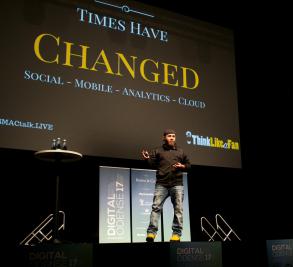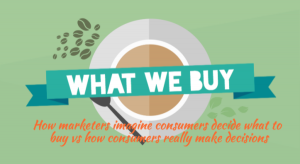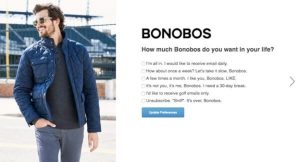Defaults are powerful, often deceivingly so. Even if you don’t put much thought into it, you’re nudging your users to act in a certain way. It’s up to you, then, to make sure that you’re nudging them to the best possible action for your company and themselves.
What Is a Default?
When two or more choices are given for a feature, a default is the option that is automatically assigned by the company or maker.
They can promote cognitive ease and can nudge users in a desirable (or sometimes undesirable direction). Often, they are simply the predetermined setting on software, and “are generally intended to make a device (or control) usable “out of the box.” Default occur and are influential in multiple domains, including but not limited to software.
 Default settings for AppSumo emails
Default settings for AppSumo emails
Consider the example of organ donorship.
Many countries operate under an ‘opt-in’ policy, where someone who would like to be an organ donor must give explicit consent to doing so. However, there is a large shortage of organ donors for the amount of organ transplants needed, and inertia makes an opt-in policy more difficult. Therefore, some countries operate under an ‘opt-out’ policy, otherwise known as presumed consent.
Does it work? Studies have consistently found that countries using opt-out systems of organ donation had higher total numbers of kidneys donated. As Richard Thaler and Cass Sunstein have reported in Nudge, “In Germany, which uses an opt-in system, only 12 percent of the citizens gave their consent, whereas in Austria, nearly everyone (99 percent) did.”
There’s also the increasingly popular method of using a mandated choice to choose whether or not to become an organ donor. In this case, when someone is applying for a driver’s license, they are required to choose whether or not to be an organ donor. This, too, seems to increase the number of donors (especially in combination with social influence, but more on that in a bit).
Why is this the case? Defaults are powerful. They are subtle factors that influence decisions in large ways and at scale. There are two closely related factors at play:
- The Power of Inertia
- Status Quo Bias
The Power of Inertia
The Power of Inertia is a fancy way of saying humans are pretty lazy with decision making. They prefer to take the path of least resistance.
Richard Thaler and Cass Sunstein wrote about this in Nudge. As they put it, “never underestimate the power of inertia.” They gave a good example about cell phones:
“When you get a new cell phone, for example, you have a series of choices to make. The fancier the phone, the more of these choices you face, from the background to the ring sound to the number of times the phone rings before the called is sent to voicemail. The manufacturer has picked one option as the default for each of these choices. Research shows that whatever the default choices are, many people stick with them, even when the stakes are much higher than choosing the noise your phone makes when it rings.”
One of the more famous academic examples of this is with 401(k) plans. As one study found, 401(k) participation is significantly higher under automatic enrollment. They also found that most of the automatic enrollment employees maintain their default contribution rate and fund allocation through time.
Here’s how the researchers put it:
“This “default” behavior appears to result from participant inertia and from employee perceptions of the default as investment advice. These findings have implications for the design of 401(k) savings plans as well as for any type of Social Security reform that includes personal accounts over which individuals have control. They also shed light more generally on the importance of both economic and noneconomic (behavioral) factors in the determination of individual savings behavior.”
Status Quo Bias
The status quo bias is when one takes the current status as a baseline and perceives any change to that to be a loss.
For a real life example, consider two states offering a new type of automotive insurance that is more expensive and includes the right to sue. The other option is less expensive and has no rights to sue. In New Jersey, the cheaper option was the default, so the majority stuck with it. In Pennsylvania, the more expensive option was the default, so a small majority elected to take the cheaper option.
Status quo bias interact with other cognitive biases like loss aversion, endowment effect, mere exposure, and regret avoidance. You could read a ton of literature on the subject, but just know that it affects the decision making process pretty consistently. Here’s a great example Thaler and Sunstein gave in Nudge:
“Status quo bias is easily exploited.
Many years ago American Express wrote Sunstein a cheerful letter telling him that he could receive, for free, three-month subscriptions to five magazines of his choice. Free subscriptions seem like a bargain, even if the magazines rarely get read, so Sunstein happily made his choices.
What he didn’t realize was that unless he took some action to cancel his subscription, he would continue to receive the magazines, paying for them at the normal rate. For about a decade, he has continued to subscribe to magazines that he hardly ever reads.”
This leads to a heuristic that Thaler and Sunstein have dubbed the “yeah, whatever” heuristic…
Yeah, Whatever Heuristic
Here’s how Thaler and Sunstein described the “yeah, whatever” heuristic:
“One of the causes of status quo bias is a lack of attention.
Many people adopt what we will call the ‘yeah, whatever’ heuristic. A good illustration is the carryover effect in television viewing. Network executives spend a lot of time working on scheduling because they know that a viewer who starts the evening on NBC tends to stay there. Since remote controls have been pervasive in this country for decades, the actual ‘switching’ costs in this context are literally one thumb press.
But when one show ends and the next one comes on, a surprisingly high number of viewers (implicitly) say, ‘yeah, whatever’ and keep watching. Nor is Sunstein the only victim of automatic renewal of magazine subscriptions.
Those who are in charge of circulation know that when renewal is automatic, and when people have to make a phone call to cancel, the likelihood of renewal is much higher than when people have to indicate that they actually want to continue to receive the magazine.”
 Producers induce a ‘carryover’ effect to keep people watching the same channel (source)
Producers induce a ‘carryover’ effect to keep people watching the same channel (source)
An example from my own life:
I signed up for Amazon Prime a while ago, when I was a college student and it was free. Why not take the offer? Today, unless I’m feeling really impatient, I tend not to care about the free two-day shipping, and I rarely if ever use other features like Amazon Prime Video. Yet I’m still signed up, paying my yearly fee (which is easier to forget about than monthly, by the way). Every time I think I should cancel, I say, “yeah, whatever.”
All of these underlying forces make default options powerful. If the chooser does nothing, or exerts little effort, we can expect the largest majority of people to end up with the default option, whether it’s good for them or not. We can also use social influence to bolster these defaults…
How Social Influence Affects Defaults
While you don’t need social proof to nudge someone towards a decision, it’s implied in certain contexts with defaults. Take, for example, the case of organ donorship in Illinois. In addition to using mandated choice with driver’s license applications, they say how many people are organ donors already. Thaler and Sunstein in Nudge:
“Second, social norms are directly brought into play in a way that builds on the power of social influences: ‘87 percent of adults in Illinois feel that registering as an organ donor is the right thing to do’ and ‘60 percent of adults in Illinois are registered.’
Recall that people like to do what most people think it is right to do; recall too that people like to do what most people actually do. The state is enlisting existing norms in the direction of lifesaving choices – and doing so without coercing anyone.”
When a designer features a certain option, say with pricing plans, it’s often implied that the option is the best and most popular option.
Considerations for Conversion Optimization
Defaults are influential in all areas of life, and they can most certainly be used to nudge users towards desirable options. Consider the simple example of installing software. There are many options for settings, yet most come with a default setup to ease you into the best user experience with the broadest appeal.
Defaults influence consumers decisions, whether or not you put too much thought into them. Thaler and Sunstein described defaults as falling into two camps, sometimes overlapping:
“Two different motives are readily apparent: helpful and self-serving. In the helpful category would be making the regular installation the default category if most users will have trouble with the custom installation. In the self-serving category would be making the default a willingness to receive emails with information about new products. In our experience, most software comes with helpful defaults regarding the type of installation, but many come with self-serving defaults on other choices.”
Successful marketers and optimizers harness the power of defaults to increase revenue and customer satisfaction. McKinsey put it well:
“Defaults work best when decision makers are too indifferent, confused, or conflicted to consider their options. That principle is particularly relevant in a world that’s increasingly awash with choices—a default eliminates the need to make a decision. The default, however, must also be a good choice for most people. Attempting to mislead customers will ultimately backfire by breeding distrust.”
Anyway, there are so many different ways defaults can be executed, both ethically and not-so-ethically. Let’s look at some common examples.
Pricing Page Defaults
Pricing pages are a common place to test defaults. Here’s an example of a pricing page that doesn’t offer any defaults, just listing all of the plans:

Though many pages will simply display all of their pricing plans on equal footing, some will accentuate one specific plan they want to nudge people towards. Here’s an example from Adobe Creative Cloud, where they push their All Apps plan here (and on other pages) by emphasizing it with a darker shade and a ‘most popular’ tag:

It’s not just SaaS pricing pages you can use defaults on. Amazon defaults to one-time purchases on some of their products but allows you to save money by getting a monthly subscription:

Default Features on Products
One of the most prominent and optimize-able examples of defaults is in product features. When shopping for a Macbook, Apple defaults to the basic features:

Closely related are default software settings, which include the ‘out of the box’ features on software that you probably don’t notice. It would be a pain to use something like Adobe Photoshop if you had to manually set up each feature individually. Defaults are engineered to give a better user experience right away, with the option to customize down the line.
Default settings also present the opportunity for ‘dark patterns.’ Here’s an example from The Verge about Apple’s iPhone. Seems that Apple’s default setting for ad tracking is not only a bit hidden, but its label is also a bit confusing (limit ad tracking is off, meaning ad tracking is on. Could be clearer):
Though they’ve since changed their site, RyanAir’s site used to have a default-based dark pattern. When you would book a flight with them, they’d offer flight insurance, but hide the option to decline it.
Not only did you have to look in a list called ‘Insurance – country of residence’, but the free option, ‘Don’t insure me’, was not distinguished at all for easy access. They’d placed it alphabetically between Denmark and Finland.
Default Subscriptions
We already talked about the example of magazine subscriptions above; marketers can snag people on continuous paid subscriptions by offering a free trial with the need to ‘opt-out’ before the paid subscription starts.
But you can also offer more ethical defaults in terms of the subscription frequency. Here’s an example from a charity, OxFam, that defaults to monthly donations:

I’ve seen many SaaS products use annual pricing as the default, with a slightly more expensive month-to-month plan available.
Email Marketing Opt-ins
At Thaler and Sunstein mentioned in Nudge, companies often use defaults to nudge people towards a better user experience when it comes to software settings, but they tend to use more self-serving defaults when it comes to marketing.
You’ll find it’s common, when ordering a product online, to need to opt-out of marketing communications. This isn’t necessarily a dark pattern, especially if it’s very apparent instead of hidden, but sometimes companies will use tricky language to make people sign up for their list. Here’s an example:
Really @Upwork I have to uncheck all of these? pic.twitter.com/beag3VA7h6
— Luiz Centenaro (@LuizCent) December 28, 2015
Optimizing for Tips
The last example is one that I consider to be an example of manipulation, and it’s one you’ve run into if you’ve gotten a cup of coffee in the last year or two.
You walk up to the register, take out your card to pay, and swipe in on the iPad POS system. Then, you’re given a tip screen, in which there are three options, $ 1, $ 2, and $ 3. Below these is the option to give ‘no tip.’ The default option, of course, is that you tip them, and because of the anchoring effect, we’re often drawn to the middle option. So we tip $ 2 on a $ 3 cup of coffee.
Nir Eyal has written about this before, and research from Software Advice backs up the power of defaults in regard to tips. They found that digital point-of-sale terminals, like the one at your coffee shop, increase the frequency and amount of tips left by customers.
Avoiding Defaults By Mandating Choice
If you want to increase the cognitive load for your user for some reason, you can require them to make a choice. This, in practice, is when you leave all boxes unchecked and required that one of the boxes is checked in order to proceed. Here’s how Thaler and Sunstein put it:
“We believe that required choice, favored by many who like freedom, is sometimes the best way to go. But consider two points about that approach. First, Humans will often consider required choice to be a nuisance or worse, and would much prefer to have a good default. In the software example, it really is helpful to know what the recommended settings are. Most users do not want to have to read an incomprehensible manual in order to determine which arcane setting to elect. When choice is complicated and difficult, people might greatly appreciate a sensible default. It is hardly clear that they should be forced to choose.”
When considering mandating choice, think about how difficult the decision is. Often, required choosing is more appropriate for simple yes-or-no decisions. “Do you want to receive our weekly newsletter?” is a great use case, and that way you ensure your list is filled with willing participants.
On the other hand, asking users to choose every little feature on a software product would not be feasible. Thaler and Sunstein give the example of ordering at a restaurant:
“At a restaurant, the default option is to take the dish as the chef usually prepares it, with the option to ask that certain ingredients be added or removed. In the extreme, required choosing would imply that the diner has to give the chef the recipe for every dish she orders! When choices are highly complex, required choosing may not be a good idea; it might not even be feasible.”
Conclusion
Defaults are a seemingly subtle element of a large and broad practice that Thaler and Sunstein dubbed “choice architecture.”
In conversion optimization, we’re certainly operating under the domain of choice architects, hopefully leading users to a better experience, and thereby increasing the bottom line for the website.
There are unlimited methods by which you can execute defaults choices, but one important thing to remember is that, no matter what you do, users are nudged in a certain direction. Even the order that you place options has a subtle effect, so it’s best to take command of your site’s choice architecture and maximize the benefit for your company and the consumer (often the same, but not always).
Avoid misdirections and dark patterns, but nudge users towards the option best suited for them.
Digital & Social Articles on Business 2 Community(2612)
Report Post













